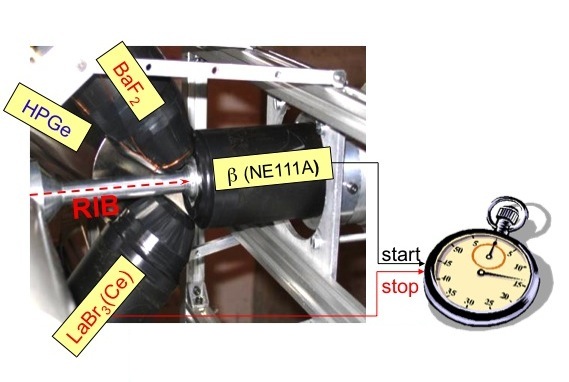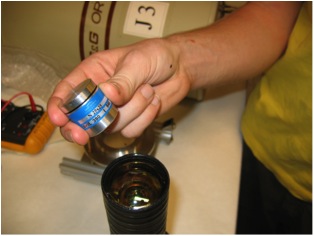Fast Timing
The measurement of the lifetime of nuclear excited states and the determination of the decay
scheme allows to unambiguously obtaining the transition probabilities, and therefore provides
key information on nuclear structure. The method of measuring lifetimes of excited nuclear
states by ultrafast coincidences, "Ultra Fast Timing" provides a direct determination of the lifetime
of a level from the time difference between the radiation populating of the nuclear
level and the de-exciting radiation. In the advanced multi-coincidence measurements on exotic
nuclei, the measured nuclear lifetimes are in the range from ~1 ps to ~30 ns, the exact
limits depending on the statistics and the production mechanism of the exotic nuclei. Simpler
techniques would be used for longer lifetimes. The method was developped by H. Mach [1] and has
been very successfully used in beta decay studies (OSIRIS, ISOLDE), in de-excitation of
microseconds isomers (GANILL, ILL) and in-beam.

The method strongly relies on precise calibrations, the application of correction procedures and the use of carefully characterized detectors and electronics. A precision of 1-2 ps is routenely obtained in beta-decay studies, where one can obtain high statistics and a proper selection of full energy events can be established. In special circumstances a precision down to 0.4 ps (the time it takes light to travel 0.12 mm!) can be achieved.

Cerium-doped LaBr3 scintillators have recently replaced the traditional fast gamma BaF2 scintillators, with FWHM time resolution better than 150 ps at 1 MeV, and energy resolution of ~9% at 661 keV. LaBr3(Ce) crystals have a better energy resolution, of the order of 3% at 661 keV, and a slightly worse time response than BaF2 at present, but that have shown great potential to improve with the proper development effort. RD activities aimed at improving the time response of LaBr3(Ce) and enabling manufacturers to produce them with the right size and shape will be crucial in upgrading the fast-timing technique. Research on other new materials with fast time response, good energy resolution, and high efficiency will also be very useful.

The method strongly relies on precise calibrations, the application of correction procedures and the use of carefully characterized detectors and electronics. A precision of 1-2 ps is routenely obtained in beta-decay studies, where one can obtain high statistics and a proper selection of full energy events can be established. In special circumstances a precision down to 0.4 ps (the time it takes light to travel 0.12 mm!) can be achieved.

Cerium-doped LaBr3 scintillators have recently replaced the traditional fast gamma BaF2 scintillators, with FWHM time resolution better than 150 ps at 1 MeV, and energy resolution of ~9% at 661 keV. LaBr3(Ce) crystals have a better energy resolution, of the order of 3% at 661 keV, and a slightly worse time response than BaF2 at present, but that have shown great potential to improve with the proper development effort. RD activities aimed at improving the time response of LaBr3(Ce) and enabling manufacturers to produce them with the right size and shape will be crucial in upgrading the fast-timing technique. Research on other new materials with fast time response, good energy resolution, and high efficiency will also be very useful.